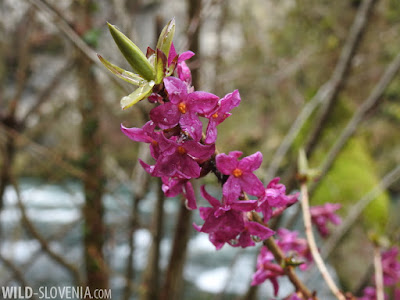We are back from an intese week of surveying and scouting in the forests of Notranjska (Inner Carniola, a region of Slovenia), for the purposes of some upcoming wildlife tours. Our base was in Loška dolina and we explored the Dinaric forests of Snežnik, Javorniki, Racna gora and Loški Potok, but also regularly checked Cerkniško jezero (Cerknica lake) and nearby areas. On Javorniki we also carried out a census of Three-toed Woodpecker for DOPPS-BirdLife Slovenia.
April is a busy season and due to our lack of time, this post will be shorter in words, but richer with photos.
Ural Owl Strix uralensis (melanistic form).
A quite rare dark morph typical of the southern ssp.
macroura (the one inhabiting Slovenia). About 5 to 15% of the Slovenian Ural Owl population are dark-coloured individuals such as the one above, seen on two different occasions in the forests of Loški Potok. We observed it hunting in daylight, while it even caught a mouse in front of our eyes!
VIDEO (watch HD).
Ural Owl Strix uralensis (light morph).
We observed/heard up to 6 of these, both in the forests of Loški Potok & Racna gora and in the Javorniki mountains. The species reaches very high population densities in this region.
 Three-toed Woodpecker Picoides tridactylus.
Three-toed Woodpecker Picoides tridactylus.
4 birds (2 m & 2 f) were found during a census for DOPPS-BirdLife Slovenia in the Javorniki mountains, while another 3 drumming females were observed in the Snežnik forests and on Racna gora.
Three-toed Woodpecker Picoides tridactylus.
Male drumming on a broken beech tree in the Javorniki mountains (chainsaw in the background).
Black Woodpecker Dryocopus martius.
More commonly heard than seen in the vast Dinaric forests. We had up to 2-3 a day, as well as several Grey-headed Woodpeckers
Picus canus on a daily basis.
Dinaric forests of beech and silver fir (Abieti-Fagetum) - Black & Three-toed Woodpecker habitat.
Red-necked Grebe Podiceps grisegena.
Performing an amazing courtship display on lake Cerknica (the specie's only breeding site in Slovenia).
White-tailed Eagle Haliaeetus albicilla.
Soaring above lake Cerknica and scaring off the wildfowl (including Pintails Anas acuta - see pic).
Common Crane Grus grus.
A flock of 2 adults and 4 juveniles resting in the flooded fields of Planinsko polje.
Hoopoe Upupa epops.
Feeding by a gravel road at lake Cerknica.
White Stork Ciconia ciconia.
Up to 4 occupied nests in the areas between Cerkniško jezero and Planina, including the characteristic nest in a tree (lower pic).
Swallow Hirundo rustica.
Now finally common in villages and towns, along with House Martins Delichon urbica and Swifts Apus apus. The forests are also echoing with the songs of the first returning Cuckoos Cuculus canorus.
Grey Heron Ardea cinerea.
A nest from the noisy colony in Loška dolina.
Fieldfare Turdus pilaris.
A common breeding bird at Cerkniško jezero and Loška dolina.
Scopolia carniolica.
We found this interesting and very typical plant for Slovenia at just one site in the forests of Notranjska, where it is not as common as in Kočevska and other regions.
Blue-eyed Mary Omphalodes verna.
One of the most characteristic flowers of Slovenian Dinaric forests.
Hacquetia epipactis.
Toothwort Lathraea squamaria.
Hollowroot Birthwort Corydalis cava.
Alternate-leaved Golden-saxifrage Chrysosplenium alternifolium & Ramsons Allium ursinum.
Mezereon Daphne mezereum.
Snake's-head Fritillary Fritillaria meleagris.
An endangered and very rare plant in Slovenia, found only in a couple of wet meadows and riparian forests. The above pic isn't from Notranjska, but from one of its classical locations at Ljubljansko barje (near Ljubljana). We visited the site on the 2nd of April and vast numbers were in bloom.








































































